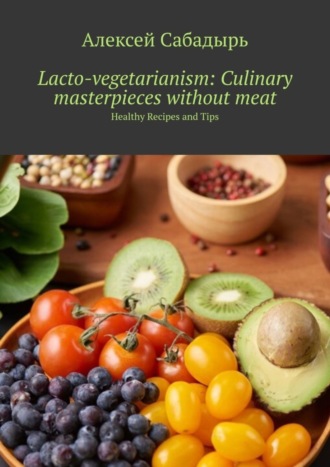
Полная версия
Lacto-vegetarianism: Culinary masterpieces without meat. Healthy Recipes and Tips

Lacto-vegetarianism: Culinary masterpieces without meat
Healthy Recipes and Tips
Алексей Сабадырь
© Алексей Сабадырь, 2025
ISBN 978-5-0062-0929-9
Created with Ridero smart publishing system
Chapter 1. Introduction to Lacto-Vegetarianism: History, Basic Principles and Benefits
Lacto – vegetarianism is a lifestyle and diet that is based on the consumption of plant foods and dairy products, excluding meat and fish. This lifestyle has a rich history in which people across cultures and times have chosen vegetarianism as a way to achieve health and spiritual harmony.
The history of lacto-vegetarianism stretches back thousands of years. Already ancient Indian texts such as the Vedas mention a vegetarian diet as a path to spiritual practice and mindfulness. In various religious traditions, many followers practice vegetarianism as a sign of respect for animals and the principle of non-creation. In today’s world, more and more people are paying attention to nutrition and its impact on the health of the planet.
The basic principles of lacto-vegetarianism include the consumption of fruits, vegetables, grains, legumes, nuts, seeds and dairy products, excluding meat, fish, poultry and products derived from them. This approach to nutrition helps provide the body with all the nutrients it needs while reducing the harmful effects of animal fats and cholesterol.
The benefits of being a lacto-vegetarian include improved health, including a reduced risk of heart disease, a boosted immune system, and reduced inflammation in the body. In addition, choosing lacto-vegetarianism can have a positive impact on the environment, as this lifestyle reduces the consumption of natural resources and harmful emissions from livestock farming.
In this book, we look at various aspects of the lacto-vegetarian diet, including health, ethical issues, recipes, and practical tips, to help you understand and participate in this lifestyle.
Chapter 2: Lacto-Vegetarian Diet Basics
A lacto-vegetarian diet is a diet that excludes meat, poultry and fish, but includes dairy products and eggs. This type of diet is an excellent choice for people who want to improve their health by following a vegetarian lifestyle while still getting the essential nutrients found in dairy products and eggs.
Eating healthily on a lacto-vegetarian diet requires some knowledge of nutrients that may be missed due to the lack of meat in the diet. In this book, we’ll look at how to get all the nutrients you need on a lacto-vegetarian diet to stay healthy and active.
In the first part of the book, we will look at the basic principles of healthy eating on a lacto-vegetarian diet, including recommendations for the consumption of proteins, fats, carbohydrates, vitamins and minerals. We will figure out which products can replace elements missing from the diet, and how best to consume them.
We’ll then look at the main nutrient groups – proteins, fats and carbohydrates – and find out which foods on a lacto-vegetarian diet can provide the body with essential vitamins and minerals such as vitamin B12, iron, zinc and calcium. We’ll also discuss how to prepare balanced meals that contain all the right nutrients while still being delicious and satisfying.
We conclude this chapter by providing practical guidance for meal planning on a lacto-vegetarian diet and sharing tips for choosing quality, fresh foods that will help you get all the nutrients you need.
Chapter 3: Lacto-Vegetarian Breakfasts
A vegetarian diet involves the absence of meat, fish and seafood, but allows the consumption of dairy products. Preparing delicious, filling and healthy breakfasts as part of a lacto-vegetarian diet can be surprisingly simple. In this chapter, we’ll look at three breakfast options that will help you start your day with a healthy, balanced meal.Omelette with vegetablesIngredients:2 eggs1/4 cup chopped tomatoes1/4 cup chopped spinach1/4 cup chopped mushrooms1/4 cup grated cheesesalt and pepper to tasteolive oilPreparation:In a bowl, beat eggs with salt and pepper.
Heat a frying pan over medium heat, add olive oil.
Pour the beaten eggs into the pan and wait until they begin to set at the edges.
Top with tomatoes, spinach, mushrooms and cheese.
Wait until the cheese begins to melt, then carefully fold the omelette in half and serve hot.
Buckwheat porridge with berries and almond milk
Ingredients:1 cup buckwheat porridge2 cups almond milk1/2 cup fresh berries (strawberries, raspberries, blueberries, etc.)1/4 cup chopped almondshoney or maple syrup for servingPreparation:
Rinse the buckwheat and boil in almond milk until the porridge is soft.
Transfer the porridge to a plate and top with fresh berries and chopped almonds.
Serve with honey or maple syrup if you want to add sweetness.
Avocado toast with fresh vegetables
Ingredients:2 slices full grain bread1 ripe avocado1 tomato, chopped1 cucumber, choppedJuice of half a lemonFresh green herbs (dill, parsley or cilantro)Salt and pepper to tastePreparation:
Toast full grain bread.
Mash the avocado pulp in a bowl, add salt, pepper and lemon juice.
Spread avocado onto toasted bread and top with sliced tomato and cucumber.
Sprinkle fresh green herbs on top and serve.
These breakfasts will not only be delicious, but also an energizing way to start your day. Enjoy the taste and nutritional value of each dish, and remember that self-care begins on the plate!
Chapter 4: Lacto-Vegetarian Diet Recipes: Three Meals
A lacto-vegetarian diet is a diet that excludes meat, poultry and fish, but includes dairy products. It differs from a regular vegetarian diet in that it allows the consumption of milk, yogurt, cheese and other dairy products. This diet is extremely healthy and allows you to get all the necessary nutrients.
Lunch is an important time to eat, so we offer you three lunch options as part of a lacto-vegetarian diet.
Light salad with buckwheat and vegetables.
To prepare this lunch you will need:
1 cup buckwheat
1 cucumber
1 tomato
1 carrot
50 g cheese
2 tablespoons olive oil
1 tablespoon vinegar
Salt, pepper to taste
Cook the buckwheat until tender and cool. Cut the cucumber, tomato, carrots and cheese into cubes and mix with buckwheat. Season the mixture with olive oil, vinegar, salt and pepper, and dinner is ready.
Omelette with vegetables.
To prepare an omelet you will need:
3 eggs
1 carrot
1 onion
1 bell pepper
50 g hard cheese
2 tablespoons milk
1 tablespoon olive oil
Salt, pepper to taste
Cut carrots, onions, peppers and cheese into cubes. Then fry the vegetables in a frying pan until soft. Beat the eggs with milk, add salt and pepper, and pour over the vegetable mixture. Fry until done and dinner is ready.
Pumpkin cream soup with coconut milk.
To prepare cream soup you will need:
500 g pumpkin
1 onion
2 cloves garlic
200 ml coconut milk
1 tablespoon olive oil
Salt, pepper, spices to taste
Cut the pumpkin into cubes, finely chop the onion and garlic. Saute the onion and garlic in olive oil, then add the pumpkin and sauté for another 5 minutes. Pour water over the vegetables, bring to a boil and cook until tender. Then puree the soup in a blender, add coconut milk, season with spices, and lunch is ready.
Preparing these lunches won’t take you much time, but will provide you with all the nutrients you need. Enjoy your lunch and stay healthy!
Chapter 5: Three different dinner recipes suitable for a lacto-vegetarian diet.
Tofu with vegetables
Ingredients:
1 pack of tofu
1 carrot
1 broccoli
1 leek
2 tablespoons soy sauce
1 tablespoon olive oil
spices to taste
Preparation:
Chop the tofu, carrots, broccoli and leeks into small pieces.
In a preheated frying pan, fry the tofu until golden brown.
Add vegetables and fry them along with tofu.
Once the vegetables are soft, add soy sauce, olive oil and spices.
Serve the dish hot.
Frittata with vegetables
Ingredients:
6 eggs
1 potato
1 onion
1 tomato
50 g hard cheese
greenery
salt pepper
Preparation:
Fry the chopped potatoes and onions in a frying pan until golden brown.
Beat eggs, add chopped tomato, fried vegetables, chopped cheese and herbs.
Pour the mixture into the pan and cook over low heat until done.
Serve hot.
Tempeh Noodles with Vegetables
Ingredients:
200 g noodles
200 g tempeh
1 red pepper
1 carrot
1 onion
3 tablespoons coconut oil
Конец ознакомительного фрагмента.
Текст предоставлен ООО «Литрес».
Прочитайте эту книгу целиком, купив полную легальную версию на Литрес.
Безопасно оплатить книгу можно банковской картой Visa, MasterCard, Maestro, со счета мобильного телефона, с платежного терминала, в салоне МТС или Связной, через PayPal, WebMoney, Яндекс.Деньги, QIWI Кошелек, бонусными картами или другим удобным Вам способом.









